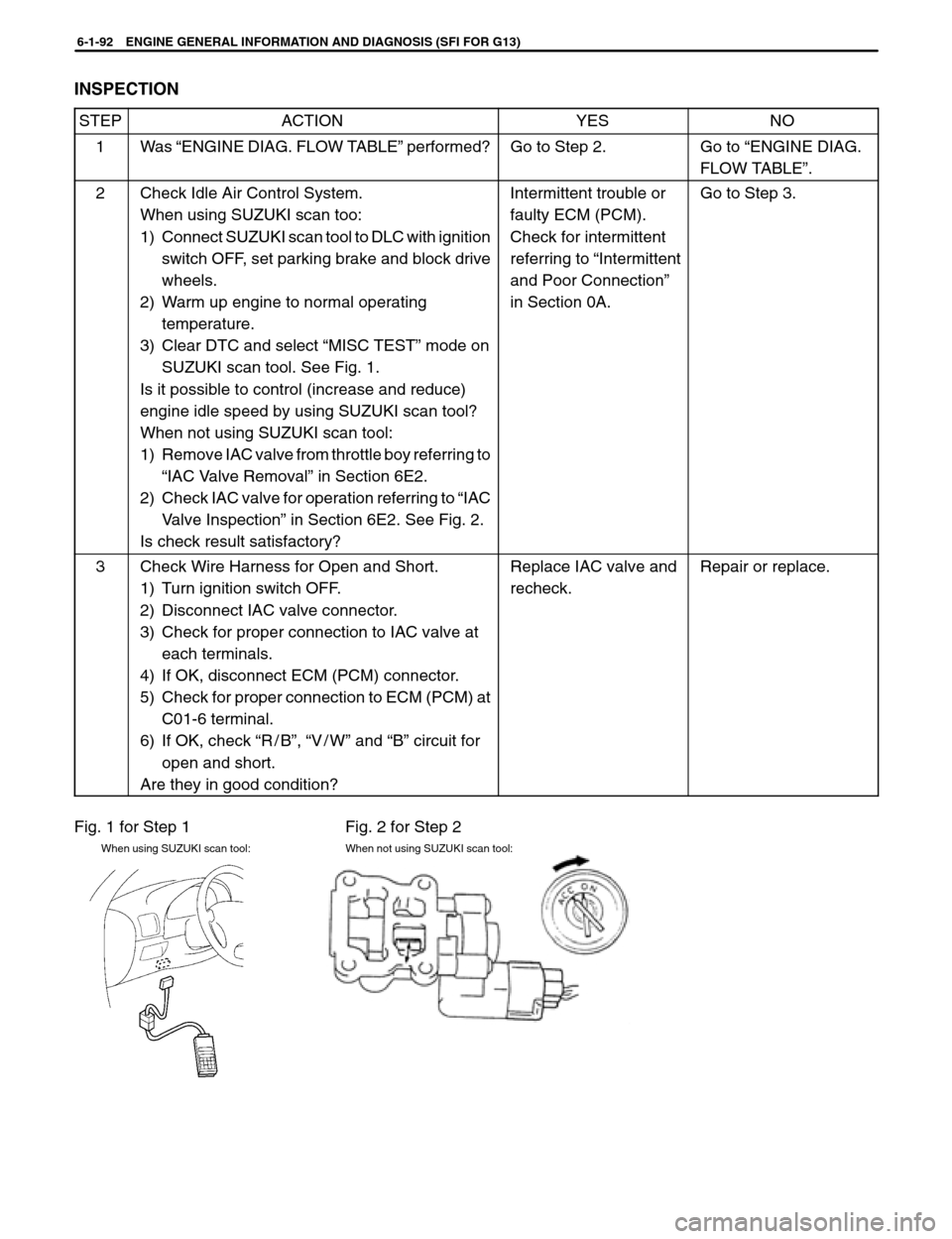Page 243 of 557

ENGINE GENERAL INFORMATION AND DIAGNOSIS (SFI FOR G13) 6-1-87
Vehicle speed
sensor in
combination meter
DTC P0500 VEHICLE SPEED SENSOR (VSS) MALFUNCTION FOR M / T
VEHICLE
CIRCUIT DESCRIPTION
DTC DETECTING CONDITIONPOSSIBLE CAUSE
�While fuel is kept cut at lower than 4000 r / min for
longer than 4 sec.
�VSS signal not inputted.
�2 driving cycle detection logic, continuous
monitoring.�Speedometer cable broken
�“P”, “Y/G” or “B/Bl” circuit open or short
�VSS malfunction
�ECM (PCM) malfunction
DTC CONFIRMATION PROCEDURE
WARNING:
�When performing a road test, select a place where there is no traffic or possibility of a traffic accident
and be very careful during testing to avoid occurrence of an accident.
�Road test should be carried out with 2 persons, a driver and a tester.
1) Clear DTC and warm up engine to normal operating temperature.
2) Increase vehicle speed to 50 mph, 80 km / h in 3rd gear.
3) Release accelerator pedal and with engine brake applied, keep vehicle coasting (fuel cut condition) for 4 sec.
or more.
4) Check pending DTC and DTC.
Page 245 of 557

Output shaft speed sensor (on A / T)
Counter
shaft
gear
ENGINE GENERAL INFORMATION AND DIAGNOSIS (SFI FOR G13) 6-1-89
DTC P0500 VEHICLE SPEED SENSOR (VSS) MALFUNCTION FOR A / T
VEHICLE
CIRCUIT DESCRIPTION
DTC DETECTING CONDITIONPOSSIBLE CAUSE
�While fuel is kept cut at lower than 4000 r / min for
longer than 4 sec.
�VSS signal not inputted.
�2 driving cycle detection logic, continuous
monitoring.�“P” or “Bl” circuit open or short.
�Vehicle speed sensor malfunction.
�Foreign material being attached or sensor installed
improperly.
�Gear damaged.
DTC CONFIRMATION PROCEDURE
WARNING:
�When performing a road test, select a place where there is no traffic or possibility of a traffic accident
and be very careful during testing to avoid occurrence of an accident.
�Road test should be carried out with 2 persons, a driver and a tester, on a level road.
1) Turn ignition switch OFF and then ON.
2) Clear DTC and warm up engine to normal operating temperature.
3) Increase vehicle speed to 50 mph, 80 km / h in “2” range.
4) Release accelerator pedal and with engine brake applied, keep vehicle coasting (fuel cut condition) for 4 sec.
or more.
5) Stop vehicle and check DTC and pending DTC.
Page 248 of 557

6-1-92 ENGINE GENERAL INFORMATION AND DIAGNOSIS (SFI FOR G13)
Fig. 1 for Step 1 Fig. 2 for Step 2
When using SUZUKI scan tool: When not using SUZUKI scan tool:
INSPECTION
STEPACTIONYESNO
1Was “ENGINE DIAG. FLOW TABLE” performed?Go to Step 2.Go to “ENGINE DIAG.
FLOW TABLE”.
2Check Idle Air Control System.
When using SUZUKI scan too:
1) Connect SUZUKI scan tool to DLC with ignition
switch OFF, set parking brake and block drive
wheels.
2) Warm up engine to normal operating
temperature.
3) Clear DTC and select “MISC TEST” mode on
SUZUKI scan tool. See Fig. 1.
Is it possible to control (increase and reduce)
engine idle speed by using SUZUKI scan tool?
When not using SUZUKI scan tool:
1) Remove IAC valve from throttle boy referring to
“IAC Valve Removal” in Section 6E2.
2) Check IAC valve for operation referring to “IAC
Valve Inspection” in Section 6E2. See Fig. 2.
Is check result satisfactory?Intermittent trouble or
faulty ECM (PCM).
Check for intermittent
referring to “Intermittent
and Poor Connection”
in Section 0A.Go to Step 3.
3Check Wire Harness for Open and Short.
1) Turn ignition switch OFF.
2) Disconnect IAC valve connector.
3) Check for proper connection to IAC valve at
each terminals.
4) If OK, disconnect ECM (PCM) connector.
5) Check for proper connection to ECM (PCM) at
C01-6 terminal.
6) If OK, check “R/B”, “V/W” and “B” circuit for
open and short.
Are they in good condition?Replace IAC valve and
recheck.Repair or replace.
Page 257 of 557

ENGINE GENERAL INFORMATION AND DIAGNOSIS (SFI FOR G13) 6-1-101
1. Fuel injector
2. Delivery pipe
3. Fuel regulator
4. Fuel filter
5. Fuel pump
Special Tool
(A) Gauge (09912-58441)
(B) Hose (09912-58431)
(C) 3-way joint (09912-58490)
TABLE B-3 FUEL PRESSURE CHECK
INSPECTION
STEPACTIONYESON
11) Release fuel pressure from fuel feed line.
2) Install fuel pressure gauge.
3) Check fuel pressure by repeating ignition switch
ON and OFF.
Is fuel pressure then 270 – 310 kPa
(2.7 – 3.1 kg / cm
2, 38.4 – 44.0 psi)?
Go to Step 2.Go to Step 5.
2Is 200 kPa (2.0 kg / cm2, 28.4 psi) or higher fuel
pressure retained for 1 minute after fuel pump is
stopped at step 1?Go to Step 3.Go to Step 4.
31) Start engine and warm it up to normal operating
temperature.
2) Keep it running at specified idle speed.
Is fuel pressure then within 200 – 240 kPa
(2.0 – 2.4 kg / cm
2, 28.4 – 34.1 psi)?
Normal fuel pressure.Clogged vacuum
passage for fuel
pressure regulator or
faulty fuel pressure
regulator.
4Is there fuel leakage from fuel feed line hose, pipe or
their joint?Fuel leakage from
hose, pipe or joint.Go to Step 10.
5Was fuel pressure higher than spec. in step 1?Go to Step 6.Go to Step 7.
61) Disconnect fuel return hose from fuel pressure
regulator and connect new return hose to it.
2) Put the other end of new return hose into approved
gasoline container.
3) Operate fuel pump.
Is specified fuel pressure obtained then?Restricted fuel return
hose or pipe.Faulty fuel pressure
regulator.
Page 259 of 557

ENGINE GENERAL INFORMATION AND DIAGNOSIS (SFI FOR G13) 6-1-103
A/C
amplifier(A / C ON output signal)
(A / C input signal)
TABLE B-4 A / C SIGNAL CIRCUITS CHECK (VEHICLE WITH A / C)
INSPECTION
STEPACTIONYESNO
1Check A / C (input) Signal Circuit.
1) Check voltage at terminal C02-16. See Fig. 1.
While engine running and A / C
switch and / or heater blower switch
OFF (A / C is not operating) : 10 – 14 V
While engine running and both
A / C switch and heater blower
switch ON (A / C is operating) : About 0 V
Are check result as specified?Go to Step 2.“Lg / B” circuit open
or short,
Evaporative
temperature is
1�C (34�F) below
or faulty A / C
system.
2Check A / C ON (Output) Signal Circuit.
1) Check voltage at terminal C02-1. See Fig. 2.
While engine running and A / C
switch and / or heater blower
switch OFF (A / C is not operating) : About 0 V
While engine running at idle speed
and both A / C switch and heater blower
switch ON (A / C is operating) : 10 – 14 V
Are check result as specified?A / C control signal
circuits are in good
condition.“G/R” circuit open
or short, Poor
performance of
ECT sensor, TP
sensor, Engine
start signal
inputted or A / C
amplifier
malfunction.
If none of the
above exists,
substitute a
known-good ECM
and recheck.
Page 266 of 557

6A-2 ENGINE MECHANICAL (G10, 1-CAM 6-VALVES ENGINE)
ON-VEHICLE SERVICE
ENGINE VACUUM CHECK
The engine vacuum that develops in the intake line is a good indica-
tor of the condition of the engine. The vacuum checking procedure
is as follows:
1) Warm up engine to normal operating temperature.
2) With engine stopped, remove blind plug hose from intake man-
ifold and connect special tool (vacuum gauge and joint) to va-
cated threaded hole.
Special Tool
(A): 09915-67311
3) Run engine at specified idle speed (see Section 6E), and read
vacuum gauge. Vacuum should be within the following specifi-
cation.
Vacuum specification: 52.6 – 65.8 kPa (40 – 50 cm
.Hg,
15.7 – 19.7 in
.Hg) at specified
idling speed
4) After checking, apply sealant to thread of blind plug and install
it to intake manifold.
OIL PRESSURE CHECK
NOTE:
Prior to checking oil pressure, check the followings.
�Oil level in oil pan.
If oil level is low, add oil up to Full level hole on oil level
gauge.
�Oil quality.
If oil is discolored, or deteriorated, change it.
For particular oil to be used, refer to the table in Section 0B.
�Oil leaks.
If leak is found, repair it.
1) Using special tool (Oil filter wrench), remove oil filter.
2) After removing oil filter, remove oil pressure switch (1) from cylin-
der block.
Page 267 of 557

3 / 4 turn
ENGINE MECHANICAL (G10, 1-CAM 6-VALVES ENGINE) 6A-3
3) Install special tool (Oil pressure gauge) to vacated threaded
hole.
Special Tool
(A): 09915-77311
(B): 09915-78211
NOTE:
At this time, be very careful not to exert force to where
heated oxygen sensor and its lead wire are connected.
4) Reinstall oil filter.
5) Start engine and warm it up to normal operating temperature.
6) After warming up, raise engine speed to 4,000 r / min and mea-
sure oil pressure.
Oil pressure specifications: 270 – 370 kPa
(2.7 – 3.7 kg / cm
2,
38.4 – 52.6 psi) at
4,000 r / min (rpm)
7) After checking oil pressure, stop engine and remove oil filter
and oil pressure gauge.
8) Before reinstalling oil pressure switch (1), be sure to wrap its
screw threads with a sealing tape and tighten switch to speci-
fied torque.
NOTE:
If sealing tape edge is bulged out from screw threads of
switch, cut it off.
Tightening Torque
(a): 14 N
.m (1.4 kg-m, 10.5 lb-ft)
9) After oiling oil filter “O” ring (rubber gasket), screw oil filter on
oil filter stand by hand until filter “O” ring contacts mounting sur-
face.
CAUTION:
To tighten oil filter properly, it is important to accurately
identify the position where filter “O” ring first contacts
mounting surface.
10) Tighten filter (1) 3 / 4 (270�) turn from the point of contact with
mounting surface using an oil filter wrench.
Special Tool
(C): 09915-47310
CAUTION:
To prevent oil leakage, make sure that oil filter is tight,
but do not overtighten it.
11) After installing oil filter, start engine and check oil filter for oil
leakage.
Page 301 of 557

6A1-6 ENGINE MECHANICAL (G13B, 1-CAM 16-VALVES ENGINE)
ENGINE VACUUM CHECK
The engine vacuum that develops in the intake line is a good indica-
tor of the condition of the engine. The vacuum checking procedure
is as follows:
1) Warm up engine to normal operating temperature.
NOTE:
After warming up engine, place transmission gear shift le-
ver in “Neutral” (shift selector lever to “P” range for A / T
model), and set parking brake and block drive wheels.
2) With engine stopped, disconnect EVAP canister purge valve
hose from intake manifold and connect 3-way joint, hoses and
special tools (vacuum gauge and joint) between intake manifold
and vacuum hose disconnected.
Special Tool
(A): 09915-67311
(B): 09918-08210
SUZUKI GENUINE PARTS
(C): Hose 09343-03087
(D): 3-way joint 09367-04002
3) Run engine at specified idle speed, and read vacuum gauge.
Vacuum should be within the following specification.
Vacuum specification (at sea level):
52.6 – 65.8 kPa (40 – 50 cm�Hg, 15.7 – 19.7 in.Hg) at specified
idling speed
4) After checking, connect vacuum hose to intake surge tank.